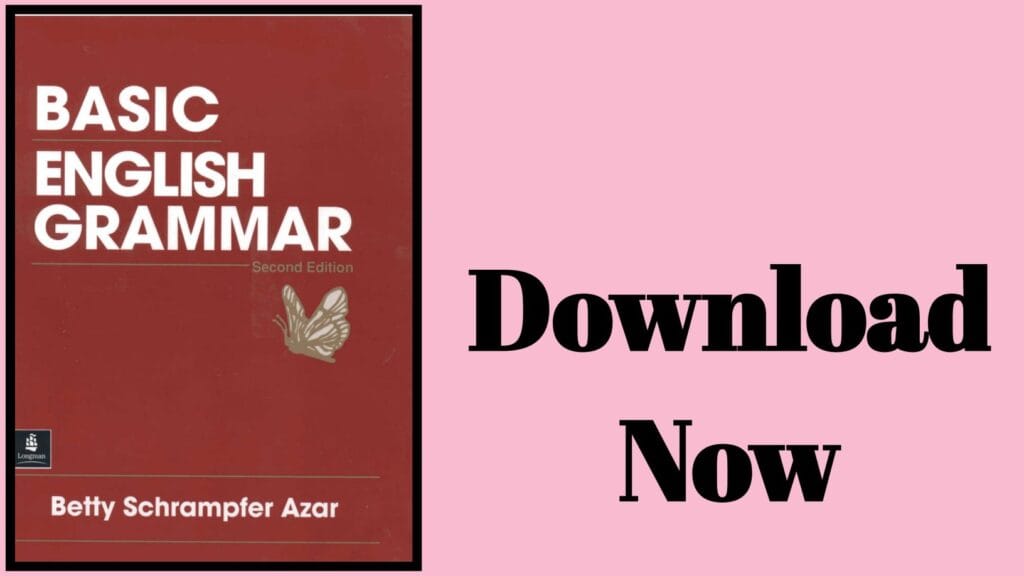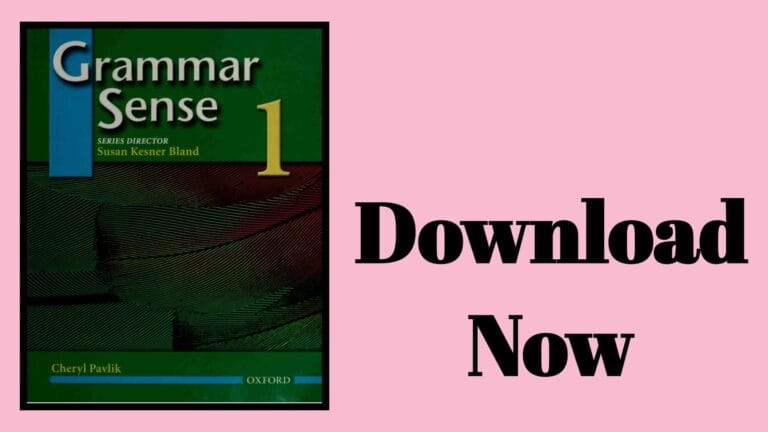
Book Description
The pdf book “Basic English Grammar”, as the name suggests, is particularly designed for the beginner learners of English grammar. If you’re new baby in the world of English grammar and have just started learning grammars of English, then this book is what you should go with for making yourself knowledgeable about the rules system of the English language.
As the name of the book hints at, you can expect basic grammar topics such as noun, pronoun, verb, adverb, adjective, preposition, conjunction and interjection, tenses, voices, helping verbs, be verb forms, articles, modal verbs: can, could, will, would, shall, should, may, might, must, dare, need, etc.
Why Read This Book?
When you just start learning the grammars and rules and sentence structures of the English language, you should look for a grammar guide book which has got a number of features which directly strengthen your base and make you feel confident when you hear the phrase “English grammar.”
Here’s why you should add this book to your reading list:
- Simplicity of Language: As you’re a beginner learner, the author has to make sure that he or she uses the simple language avoiding jargons and technical terminology to ensure the readers’ understanding faculty power so that the readers can easily comprehend what the author is saying. You know what? this book has made this feature.
- All Essential Topics: It’s hilarious to think of learning an advanced grammar topic without even completing all the basic topics which are crucial in understanding the further more advanced topics of grammar. The writer, therefore, made a special effort to meet this requirement by discussing all the required basic grammar topics.
- Usages of Words: A grammar book should not only teach you a certain number of rules but also explain to you the common terms that you often need to use in your conversations. The book talks about a great number of such words that are frequent in everyday conversations.
Table of Contents
Please go through the table of contents in order to make that this book is best fit for you and your level. This table of contents gives an idea of what you should be expecting from it and what you should be extracting from it after you’ve dedicated your time and energy to it.
Preface to the Second Edition
Acknowledgments
Chapter 1: Using BE and HAVE
Noun + IS + Noun: Singular
Noun + ARE + Noun: Plural
Pronoun + BE + Noun
Contractions with BE
Negative with BE
BE + Adjective
BE + A Location
Summary: Sentence Patterns with BE
Yes/No Questions with BE
Questions with BE: Using WHERE
Using HAVE and HAS
Using MY, YOUR, HIS, HER, OUR, THEIR
Using THIS and THAT
Using THESE and THOSE
Asking Questions with WHAT and WHO + BE
Chapter 2: Expressing Present Time (Part 1)
Form and Basic Meaning of the Simple Present Tense
Using Frequency Adverbs: ALWAYS, USUALLY, OFTEN, SOMETIMES, SELDOM, RARELY, NEVER
Pronunciation of Final -S: /Z/ and /S/
Spelling and Pronunciation of Final -ES
Adding Final -S/-ES to Words That End in -Y
Irregular Singular Verbs: HAS, DOES, GOES
Summary: Spelling and Pronunciation of -S and -ES
The Simple Present: Negative
The Simple Present: Yes/No Questions
The Simple Present: Asking Information Questions with WHERE
The Simple Present: Asking Information Questions with WHEN and WHAT TIME
Summary: Information Questions with BE and DO
Using IT to Talk About Time
Prepositions of Time
Using IT to Talk About the Weather
Chapter 3: Expressing Present Time (Part 2)
BE + -ING: The Present Progressive Tense
Spelling of -ING
The Present Progressive: Questions
The Present Progressive vs. The Present
Nonaction Verbs Not Used in the Present Progressive
SEE, LOOK AT, WATCH, HEAR, and LISTEN TO
NEED and WANT + A Noun or an Infinitive
WOULD LIKE
WOULD LIKE vs. LIKE
THINK ABOUT and THINK THAT
THERE + BE
THERE + BE: Yes/No Questions
THERE + BE: Asking Questions with HOW MANY
Prepositions of Location
Chapter 4: Nouns and Pronouns
Nouns: Subjects and Objects
Adjective + Noun
Subject Pronouns and Object Pronouns
Nouns: Singular and Plural
Nouns: Irregular Plural Forms
Nouns: Count and Noncount
Using AN vs. A
Using A/AN vs. SOME
Measurements with Noncount Nouns
Using THE
Using Ø (No Article) to Make Generalizations
Using SOME and ANY
Indefinite Pronouns: SOMETHING, SOMEONE, ANYTHING, ANYONE
Indefinite Pronouns: NOTHING and NO ONE
Chapter 5: Expressing Past Time
Using BE: Past Time
Past of BE: Negative
Past of BE: Questions
The Simple Past Tense: Using -ED
Past Time Words: YESTERDAY, LAST, and AGO
Pronunciation of -ED: /t/, /d/, and /əd/
Spelling of -ED Verbs
Spelling of -ED and -ING: Two-Syllable Verbs
The Simple Past: Irregular Verbs
The Simple Past: Negative
The Simple Past: Yes/No Questions
More Irregular Verbs
The Simple Past: Using WHERE, WHEN, WHAT TIME, and WHY
Questions with WHAT
Questions with WHO
Asking About the Meaning of a Word
More Irregular Verbs
BEFORE and AFTER in Time Clauses
WHEN in Time Clauses
Chapter 6: Expressing Future Time
Future Time: Using BE GOING TO
Words Used for Past Time and Future Time
Using A COUPLE OF or A FEW with AGO (Past) and IN (Future)
Using TODAY, TONIGHT, and THIS + Morning, Afternoon, Evening, Week, Month, Year
Future Time: Using WILL
Asking Questions with WILL
Verb Summary: Present, Past, and Future
Verb Summary: Forms of BE
Using WHAT + A Form of DO
MAY/MIGHT vs. WILL
MAYBE (One Word) vs. MAY BE (Two Words)
Future Time Clauses with BEFORE, AFTER, and WHEN
Clauses with IF
Expressing Habitual Present with Time Clauses and IF-Clauses
More Irregular Verbs
More Irregular Verbs
Chapter 7: Expressing Ability
Using CAN
Using CAN: Questions
Using KNOW HOW TO
Using COULD: Past of CAN
Using VERY and TOO + Adjective
Using TOO MANY and TOO MUCH + Noun
Using TOO + Adjective + Infinitive
Using TOO + Adjective + FOR (Someone) + Infinitive
Using Adjective + ENOUGH
Using ENOUGH + Noun and MORE + Noun
Using ENOUGH + Infinitive
Using BE ABLE TO
Polite Questions: MAY I, COULD I, and CAN I
Polite Questions: COULD YOU and WOULD YOU
Imperative Sentences
Using TWO, TOO, and TO
More About Prepositions: AT and IN for Locations
More Irregular Verbs
Chapter 8: Nouns, Adjectives, and Pronouns
Modifying Nouns with Adjectives and Nouns
Word Order of Adjectives
Expressions of Quantity: ALL OF, MOST OF, SOME OF
Expressions of Quantity: Subject-Verb Agreement
Expressions of Quantity: ONE OF, NONE OF
Using EVERY
Possessive Nouns
Possessive: Irregular Plural Nouns
Possessive Pronouns: MINE, YOURS, HIS, HERS, OURS, THEIRS
Questions with WHOSE
Summary: Uses of the Apostrophe
Summary: Uses of Nouns
Connected Nouns: Noun + AND/OR + Noun
Summary: Uses of Adjectives
Summary: Personal Pronouns
Indirect Objects
Indirect Objects: Using FOR
Indirect Objects with BUY, GET, MAKE
Indirect Objects with EXPLAIN and INTRODUCE
More Irregular Verbs
Chapter 9: Making Comparisons
Comparisons: Using THE SAME (AS), SIMILAR (TO), and DIFFERENT (FROM)
Comparisons: Using LIKE and ALIKE
The Comparative: Using -ER and MORE
Using AS … AS; Using LESS
Using BUT
Using Verbs After BUT
The Superlative: Using -EST and MOST
Using ONE OF + Superlative + Plural Noun
Adjectives and Adverbs
Making Comparisons with Adverbs
Using AS … AS with Adverbs
Chapter 10: Expressing Ideas with Verbs
Using SHOULD
Using LET’S
Using HAVE + Infinitive (HAS TO / HAVE TO)
Using MUST
Modal Auxiliaries
Summary Chart: Modal Auxiliaries and Similar Expressions
The Present Progressive and the Past Progressive
Using WHILE with the Past Progressive
WHILE vs. WHEN in Past Time Clauses
Simple Past vs. Past Progressive
Using HAVE BEEN (The Present Perfect)
Using SINCE-Clauses
Form of the Present Perfect
Using NEVER with the Present Perfect
Present Perfect: Questions and Negatives
Using EVER with the Present Perfect
The Present Perfect: Questions with HOW LONG
Past Participles of Common Irregular Verbs
Appendices
1. The English Alphabet
2. Numbers
3. Days of the Week and Months of the Year
4. Ways of Saying the Time
5. Irregular Verbs
Index



hi